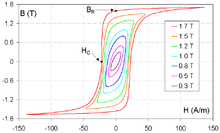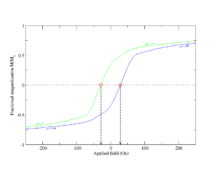- Coercivity
-
This article is about a property of magnetic fields. For other meanings, see Coercion (disambiguation).
 A family of hysteresis loops for grain-oriented electrical steel (BR denotes remanence and HC is the coercivity).
A family of hysteresis loops for grain-oriented electrical steel (BR denotes remanence and HC is the coercivity).
In materials science, the coercivity, also called the coercive field or coercive force, of a ferromagnetic material is the intensity of the applied magnetic field required to reduce the magnetization of that material to zero after the magnetization of the sample has been driven to saturation. Thus coercivity measures the resistance of a ferromagnetic material to becoming demagnetized. Coercivity is usually measured in oersted or ampere/meter units and is denoted HC. It can be measured using a B-H Analyzer or magnetometer.
Ferromagnetic materials with high coercivity are called magnetically hard materials, and are used to make permanent magnets. Permanent magnets find application in electric motors, magnetic recording media (e.g. hard drives, floppy disks, or magnetic tape) and magnetic separation.
Materials with low coercivity are said to be magnetically soft. They are used in transformer and inductor cores, recording heads. microwave devices, and magnetic shielding.
Contents
Experimental determination
Typically the coercivity of a magnetic material is determined by measurement of the hysteresis loop,[1] also called the magnetization curve, as illustrated in the figure. The apparatus used to acquire the data is typically a vibrating-sample or alternating-gradient magnetometer. The applied field where the data line crosses zero is the coercivity. If an antiferromagnet is present in the sample, the coercivities measured in increasing and decreasing fields may be unequal as a result of the exchange bias effect.
Coercivities of soft and hard magnets:
hardness grows as crystal (domain) size and strew,
shrinks as smoothness or glassinessMaterial Coercivity
[Oe][.1Mn:]6Fe:27Ni:Mo, Supermalloy 0.002 Fe:4Ni, Permalloy 0.01–1 .9995 iron–filings 0.05–470 11Fe:Si, silicon iron 0.4–0.9 Raw iron 2 (1896) .99 Nickel 0.7–290 ZnxFeNi1-xO3,
ferrite for magnetron15–200 2Fe:Co, Iron pole 240 >.99 cobalt 10–900 6Al:18Fe:8Co:Cu:6Ni–
3Ti:8Al:20Fe:20Co:2Cu:8Ni,
alnico 5–9, fridge magnet and stronger640–2000 Cr:Co:Pt,
disk drive recording media1700 2Nd:14Fe:B, neodymium-iron-boron 10,000–12,000 12Fe:13Pt, Fe48Pt52 12,300+[2] ?(Dy,Nb,Ga,Co):2Nd:14Fe:B 25,600–26,300 2Sm:17Fe:3N, samarium-iron-nitrogen <500–35,000 (10 K) Sm:5Co, samarium-cobalt 40,000 The coercivity of a material depends on the time scale over which a magnetization curve is measured. The magnetization of a material measured at an applied reversed field which is nominally smaller than the coercivity may, over a long time scale, slowly relax to zero. Relaxation occurs when reversal of magnetization by domain wall motion is thermally activated and is dominated by magnetic viscosity.[3] The increasing value of coercivity at high frequencies is a serious obstacle to the increase of data rates in high-bandwidth magnetic recording, compounded by the fact that increased storage density typically requires a higher coercivity in the media.[citation needed]
Theory
At the coercive field, the vector component of the magnetization of a ferromagnet measured along the applied field direction is zero. There are two primary modes of magnetization reversal: single-domain rotation and domain wall motion. When the magnetization of a material reverses by rotation, the magnetization component along the applied field is zero because the vector points in a direction orthogonal to the applied field. When the magnetization reverses by domain wall motion, the net magnetization is small in every vector direction because the moments of all the individual domains sum to zero. Magnetization curves dominated by rotation and magnetocrystalline anisotropy are found in relatively perfect magnetic materials used in fundamental research.[4] Domain wall motion is a more important reversal mechanism in real engineering materials since defects like grain boundaries and impurities serve as nucleation sites for reversed-magnetization domains. The role of domain walls in determining coercivity is complex since defects may pin domain walls in addition to nucleating them. The dynamics of domain walls in ferromagnets is similar to that of grain boundaries and plasticity in metallurgy since both domain walls and grain boundaries are planar defects.
Significance
As with any hysteretic process, the area inside the magnetization curve during one cycle represents the work that is performed on the material by the external field in reversing the magnetization,[1] and is dissipated as heat. Common dissipative processes in magnetic materials include magnetostriction and domain wall motion. The coercivity is a measure of the degree of magnetic hysteresis and therefore characterizes the lossiness of soft magnetic materials for their common applications.
The squareness (saturation remanence divided by saturation magnetization) and coercivity are figures of merit for hard magnets although energy product (saturation magnetization times coercivity) is most commonly quoted. The 1980s saw the development of rare earth magnets with high energy products but undesirably low Curie temperatures. Since the 1990s new exchange spring hard magnets with high coercivities have been developed.[5]
See also
References
- Chen, Min; Nikles, David E. (2002). "Synthesis, self-assembly, and magnetic properties of FexCoyPt100-x-y nanoparticles". Nano Letters 2 (3): 211–214. doi:10.1021/nl015649w.
- Gaunt, P. (1986). "Magnetic viscosity and thermal activation energy". Journal of Applied Physics 59 (12): 4129–4132. Bibcode 1986JAP....59.4129G. doi:10.1063/1.336671.
- Genish, Isaschar; Kats, Yevgeny; Klein, Lior; Reiner, James W.; Beasley, M. R. (2004). "Local measurements of magnetization reversal in thin films of SrRbO3". physica status solidi (c) 1 (12): 3440–3442. doi:10.1002/pssc.200405476.
- Kneller, E. F.; Hawig, R. (1991). "The exchange-spring magnet: a new material principle for permanent magnets". IEEE Transactions on Magnetics 27 (4): 3588–3560. Bibcode 1991ITM....27.3588K. doi:10.1109/20.102931.
- Livingston, J. D. (1981). "A review of coercivity mechanisms". Journal of Applied Physics 52 (3): 2541–2545. Bibcode 1981JAP....52.2544L. doi:10.1063/1.328996.
- Lapshin, R. V. (1995). "Analytical model for the approximation of hysteresis loop and its application to the scanning tunneling microscope" (PDF). Review of Scientific Instruments (USA: AIP) 66 (9): 4718–4730. Bibcode 1995RScI...66.4718L. doi:10.1063/1.1145314. ISSN 0034-6748. http://www.nanoworld.org/homepages/lapshin/publications.htm#analytical1995. (Russian translation is available).
External links
- Magnetization reversal applet (coherent rotation)
- For a table of coercivities of various magnetic recording media, see "Degaussing Data Storage Tape Magnetic Media" (PDF), at fujifilmusa.com.ml-Coercivity
Categories:- Physical quantities
- Condensed matter physics
- Magnetic ordering
Wikimedia Foundation. 2010.

